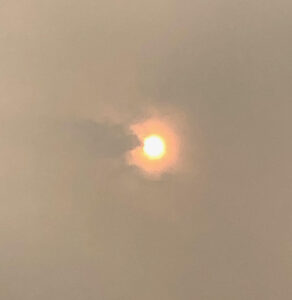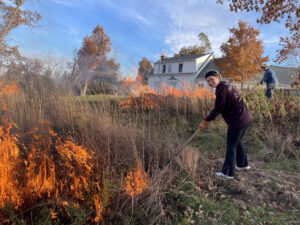Smoke Gets In Our Eyes
We sat on our deck on a June 2024 evening and breathed air carrying the season’s first waves of smoke wafting from Canadian fires. Last summer the smoke was so thick visibility shrank to less than a mile. We don’t remember such thick smoke in the past. What’s going on?
- Thick smoke obscures the sun.
- Smoke drifts
The answer is. Lots!. Here’s a brief fire history and our half-century involvement with fire and smoke.
Fire’s Cultural History
Indigenous People and Fire
If we sat where our house now stands a thousand years ago, we’d likely have seen smoke. Native Americans routinely set fires that burned through grasslands and forests. Fires transformed the landscape by stimulating grass, killing brush, and favoring fire-resistant plants. In many areas burns prevented the formation of dense woods. Instead, the fire created savannas, widely spaced big trees that towered over soil clothed with grasses, wildflowers, and sedges. These ground-hugging plants nourished bison and elk that provided human food. Shrubs were rare, giving the forest a feeling of “openness”. Fires were an integral part of Native American culture, forming the landscape early Europeans discovered when their sailing ships made landfall.
Europeans and Fire
European culture viewed fire differently. It was considered destructive and wasteful. From early settlement days until relatively recently people eagerly extinguished fires. Aversion to fire became government policy, birthed Smokey Bear, and began the Patterson’s fire journey.
An Idaho Fire
Fifty years ago, Rich was armed with a chainsaw on a high ridge in the Boise National Forest. As fellow crewmates hastily scratched a fire line Rich felled trees downhill toward flames galloping uphill. Hopefully, their fire line would stop the inferno. Help came from above. A noisy slurry bomber dropped fire retardant along the new fire line. It worked! As the fire reached the line it halted.
We were on that smokey ridge because of the Forest Service’s “10 a.m. policy”, which stated that all wildfires would be extinguished by the next morning. The old rule once made sense to a fire-averse culture that didn’t understand fire ecology.
Today’s Wildfires Management
Gradually the science of fire ecology emerged to help us understand the critical role flames play in ecosystem health. The old “10 a.m. rule” is now history, and today’s land managers set prescribed burns. Why?
Well, Rich has personal experience. In 1989 he set a fire in the Indian Creek Nature Center’s oak woodland. “Fire killed understory shrubs of mostly invasive exotic species and stimulated long suppressed sedges, grasses, and wildflowers. After a few years light-demanding young oaks sprouted under the rather open canopy of parent trees.”
How Periodic Fires Help
Periodic fires sort vegetation by retarding plants sensitive to burns while encouraging resistant ones. Low-intensity periodic fires also burn fallen branches and other fuel that, if left unburned, accumulates to enable a future more intensive burn.
- Careful burning of woodlands
- Fires help understory
Our Continued Fire Bias
Americans will see examples of fire bias on the nightly TV news this summer. Reporters flock to big fires, especially in the West. They’ll show the charred and smoking remains of a fire and say, “Over 120,000 acres of forest were destroyed this week”. Well, no. Fires, don’t destroy forests. They change and often invigorate them. Fires are a natural form of land disturbance that many plants need to thrive. Journalism fails by not returning to a burn site a few years later to show a verdant growth of new trees…..it’s the rest of the story that many Americans don’t understand.
So Why So Many Fires and So Much Smoke Now
We’re breathing wildfire smoke for two significant reasons. One is our old fire bias.
For a century we’ve done such a good job suppressing fire that forests are choked with dead fallen branches and tangles of small trees that feed hot and intense burns. These hot fires can kill mature trees and spew forth an abundance of smoke. Social bias created these tinderbox woods.
Then there’s climate change. Ecosystems are hotter, dryer, wetter, soggier, and windier. A forest suffering through unprecedented hot drought and overstocked with fuel is a recipe for burns big enough to envelop much of the continent in smoke. According to the University of Idaho’s Dr. Leda N. Kobziar climate change is increasing the availability of fuel, like deep organic soils in northern Canada that now burn.
What is In Smoke?
Is that smoke bad? Well, maybe, and maybe not. Smoking cigarettes causes health issues. Wildfire smoke isn’t as intense or prolonged as that which directly enters the lungs from a cigarette but it can cause breathing problems. Breathing smoky air isn’t healthy.
Research Points the Way
Smoke may have benefits. Dr. Kobziar’s research is investigating the impacts of fire that are beyond the visible. It’s easy to see the physical changes that a burn causes, like Rich’s observation of enhanced wildflower abundance after a burn at the Nature Center. Dr. Kobziar’s team has found that within millions of floating smoke particles is a host of microbes. Microbes! Sounds bad, but these aren’t always tiny creatures that infect people. Smoke transports beneficial microbes that help enhance the health of forest soils but can also move fungi that can infect people. “There’s a lot yet to learn,” said Dr. Kobziar. To read more about this fascinating concept visit.
Managers of grasslands and forests now often set prescribed burns to consume fuel and increase ecosystem health. Normally prescribed burns are held at times and under weather conditions that produce less smoke than wildfires.
- Regenerating the labyrinth
- workers pull fire along to set other areas ablaze.
- Ready for summer’s fullness.
- Brilliant flowers
Upshot
It looks like we’re up for a smoky summer. It’s understandable why the woods, and even the soil, are burning and spewing forth clouds of smoke.
This is one of three blogs stemming from our recent visit to our alma mater, the University of Idaho. This outstanding college offers, among others, majors in natural science, education, and architecture.









